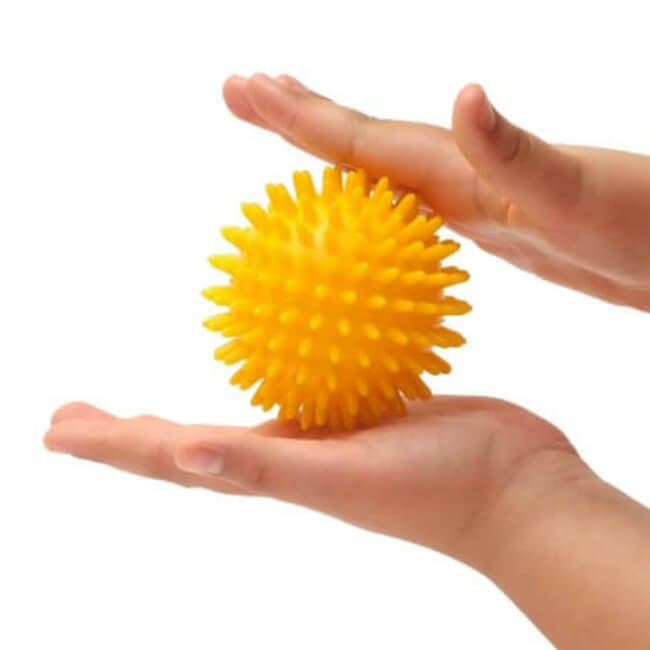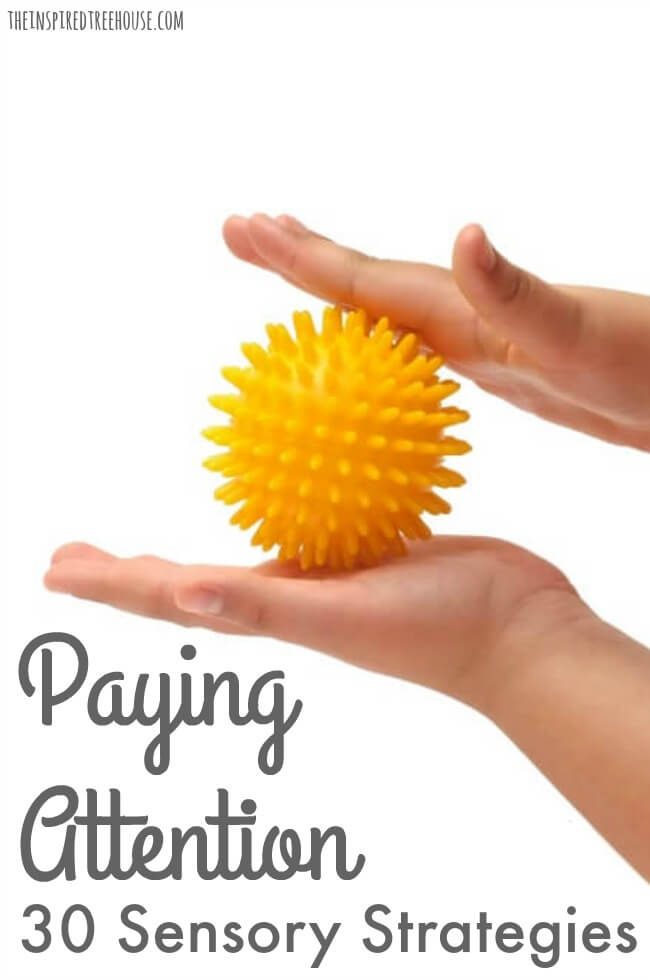These days, it’s not uncommon to hear about kids who have difficulty with paying attention. They can’t sit still, they can’t keep their eyes on what they’re doing, or they miss important instructions and details.
Sensory Processing and Attention
Our sensory systems help keep our bodies and minds at an optimal state of alertness and arousal for any given situation. Calm enough to listen, attend, work, and engage but not so calm that we’re falling asleep. Alert enough that we can take in the information in our surroundings and be ready to respond, but not so alert that we’re hyperactive and bouncing off the walls.
Some children who experience difficulty with paying attention may need less sensory input because they become distracted or overwhelmed by certain sensory experiences. However, many children are better able to attend to and participate when tasks appeal to the senses. They need more sensory input to regulate themselves and stay focused.
For these kids, adding a sensory component or enhancing the existing sensory features of an activity can be helpful to promote attention and engagement. The following sensory strategies can help children who require more sensory input to remain focused and attentive.
Sensory Strategies to Help With Paying Attention

RISE With Sensory Course
Are you ready to learn powerful sensory strategies to support kids’ sensory needs so they can RISE to their full potential?
Whether you’re a parent or a professional, this course is for you!
The RISE With Sensory Course is This class is AOTA approved for 7 hours (.7 CEU) and is the perfect starting point for new therapists, or refresher for experienced therapists.
Looking for a streamlined approach for working with kids with sensory concerns and for communicating clearly with parents and caregivers about sensory processing?
Click here to learn more!
Auditory Strategies for Attention
Some children need more auditory input to attend. These children may miss important details or instructions that are presented verbally. They may not respond when the teacher calls on them, or they may find ways to generate their own noise to stay focused (humming, singing, tapping, and making strange noises). For these children, try:
1 || Making up songs or rhymes to bring attention to a task (e.g. instead of telling a child to get dressed and then brush his teeth, make up a song to grab his attention and help him remember what he’s supposed to do; make up songs and rhymes to help the child learn and remember academic concepts)
2 || Having the child repeat instructions or important information back to you
3 || Including breaks throughout the day with active movement songs and music
4 || Sensory breaks using musical toys
5 || Exposure to games and apps that teach concepts using music and sound
6 || Use your body to build sound into learning (e.g. clapping out syllables of words, stomping feet to count out the days on the calendar, snapping fingers while counting by 10s)
Visual Strategies for Attention
Some children need more visual input to help them attend. They may miss instructions that are written on the page or barely notice the visual details in their surroundings. They may lose interest and focus on visual activities like reading. For these children, try:
7 || Using learning materials that are bold, bright, and colorful
8 || Working or playing on a brightly colored surface
9 || Highlighting or using color to draw attention to important details on worksheets and in books
10 || Work and play on the computer or tablet using programs and apps that incorporate movement and color
11 || Visual cues like sticker charts, picture schedules, and checklists
12 || Visual learning activities like: word searches, hidden picture pages, color by number pages, word scrambles
13 || Learning activities that incorporate visual discrimination (sorting, finding which one is different)
14 || Learning activities on a light table
15 || Sensory breaks with visual activities like sensory bottles or seek and find bottles filled with dry rice and small objects to find
Tactile Strategies for Attention
Many children are best able to pay attention when their tactile systems are engaged. These kids are hands-on learners who love to touch and be touched. For these kids try:
16 || Learning and play with manipulatives and hands-on materials rather than pencil and paper (e.g. building with Legos for math, stringing beads to learn about patterns, adapting worksheets to make them into a cut-and-paste format rather than written)
17 || Combining learning materials with tactile bins (e.g. digging for math flash cards or letter magnets in a bin filled with sand or dry rice)
18 || Incorporating vibration with tools like ARK’s Tran-Quill Writing Kit. This is a textured, vibrating writing utensil that draws kids’ attention to writing, drawing, and coloring by providing tactile feedback. It comes with pen, pencil, and crayon attachments as well as Bite-n-Chew tips for kids who also need some extra oral sensory input during learning activities.
19 || Adapting learning materials to incorporate texture. Try tracing over text using puffy paint or a hot glue gun. Cut letters and numbers out of textured paper or sandpaper for little hands to touch.
20 || Tactile sensory breaks that provide deep pressure (bear hugs, smushes with pillows or beanbag chairs) and play with tactile materials like play dough and shaving cream
21 || Fidget toys for kids to hold and play with in their hands when they have to listen or pay attention for extended periods of time
Movement Strategies for Attention
Many, if not most, children need to MOVE to attend and to learn! It’s one of the main messages we preach here at The Inspired Treehouse. Children were simply not built to sit for extended periods of time, so the best way to engage little minds is by moving little bodies! For children who benefit from extra movement throughout the day, try:
22 || Offering frequent changes in positions. One method is to move children through work stations in the classroom to complete a task at teach station. Allow children to complete classwork or homework while sitting or lying on the floor with a clipboard, sitting on a beanbag chair, or even lying under the table with their work taped to the underside of the table!
23 || Offering different seating options that provide movement such as inflatable seat cushions, rocking chairs, ball chairs, etc.
24 || Building movement into learning whenever possible. Set math fact flashcards out on the floor and make it a relay race to run, skip, jump, or gallop to pick one up and give an answer! Use body movements to help kids remember letter sounds. Tape sight word cards at various heights on the wall and have the child jump to touch them as you read them one by one.
25 || Including movement breaks regularly throughout the day and during transitions. Try movement breaks with vestibular activities like swinging, rolling, balancing,and rocking or proprioceptive activities that require movement against resistance (heavy work).
Oral Sensory and Olfactory Strategies for Attention
Some kids are able to attend better when they receive sensory input that appeals to the oral sensory and olfactory systems. Certain smells, tastes, and textures have been associated with more attentive behavior in children. For kids who benefit from oral and olfactory input, try:
26 || Chewing tools like ARK’s Y-Chews, and Tri-Chews. Or try Grabbers, which also come in scented versions to target the oral sensory and olfactory systems at the same time!
27 || Adding chewing accessories to pencils, like ARK’s colorful and durable Krypto-Bite Chewable Pencil Toppers.
28 || Wearable chewing tools to make it easy for kids to get the oral sensory input they need whenever they need it. Try ARK’s Krypto-Bite Chewable Gem Necklace or the cool Brick Stick Textured Chew Necklace.
29 || Snacks! Chewy snacks and treats like bagels, gum, and fruit leathers are typically associated with calmer, more attentive behavior in children. Sucking against resistance can also help children focus and organize themselves. Try sucking a thicker liquid like a smoothie through a straw or drink out of a sports bottle. Crunchy, cold, and sour snacks and drinks like orange wedges, grapefruit, or lemonade can help to promote more alert, active behavior for kids who appear sluggish or tired. Learn more about oral sensory snacks here.
30 || Incorporating smells using oils, scented doughs, scented sensory bins, and other activities to explore the olfactory system. Stronger smells (e.g. peppermint) often correspond with more alert and active behavior while softer smells (e.g. lavender) are usually associated with calmer, more relaxed behavior.


Latest posts by Claire Heffron (see all)
- Fairy Tale Games and Toys - April 12, 2024
- The Best Emotional Regulation Books for Kids - April 8, 2024
- Fairy Tales Games: Gross Motor Obstacle Course - April 4, 2024


[…] own pals and bash team might not recognize the reversal of management. Ensure that the individual Paying Attention: 30 Sensory Strategies – The Inspired Treehouse who you employ can be a professional from the area that your son or daughter prerequisites. When […]